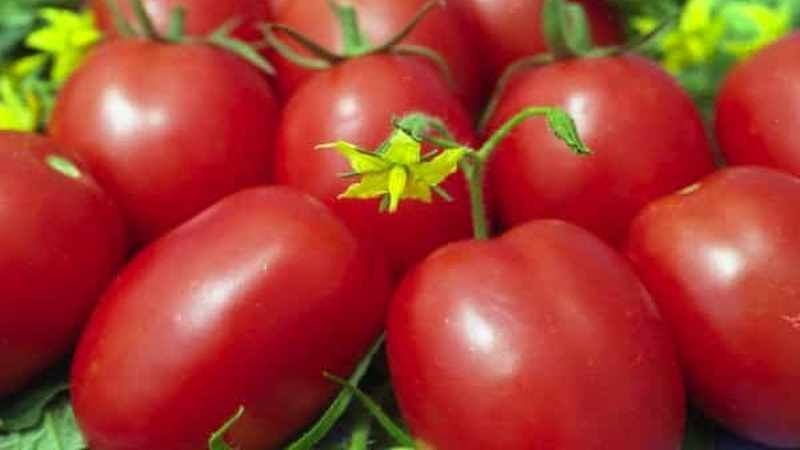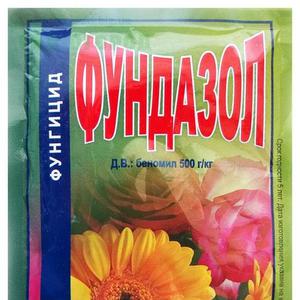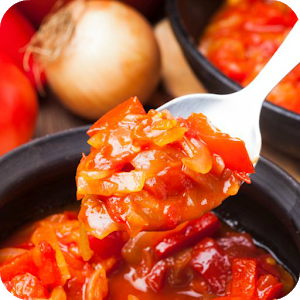One of the oldest varieties of vegetable selection is the Gloria tomato: a time-tested variety
The Gloria tomato is one of the oldest, but favorite varieties of our gardeners. It has been cultivated in Russia and the near abroad for about 50 years - a record time for tomato varieties. It is unpretentious, produces a large harvest and tastes great. Good for fresh consumption, suitable for making pickles, sauces and juices.
In this article, you will learn all the features of the variety and useful recommendations for growing it.
The content of the article
Description of the variety
The variety was bred in 1970 by the Moldavian Research Institute of Irrigated Agriculture and Vegetable Growing. In 1975, it was zoned on the territory of the North Caucasus, Tajikistan, the central black earth regions, in the Ukraine and in the Volga region. Having established itself from the best side in these territories, the variety began to be cultivated in other regions of the former USSR.
Gloria tomato gives a high yield, up to 4 kg per bush. It does not require much attention, it is suitable for both open ground and greenhouses. In open ground it grows up to a meter in height, in a greenhouse - up to 1.5 m.
Fruits resemble plums in shape, weight from 100 to 200 g. Sweet, with slightly sour taste. They have a dense, elastic shape and at the same time are quite fleshy.

Fruit characteristics:
- color - red;
- shape - rounded oval (see photo);
- pulp - a pleasant consistency;
- consumer qualities are high;
- transportability is good;
- keeping quality is about 60 days.
Such tomatoes are ideal for fresh consumption and in salads, good in pickling and canning.
How to grow seedlings
Sowing time for Gloria tomato seedlings depends on the place of cultivation. For open ground, sow seeds not earlier than the end of February, for a greenhouse - in early March.
Important! When choosing tomato seeds, be sure to pay attention to their release date. The best germination will be in seeds produced no more than 2 years ago.
Seed preparation
To begin with, the seeds are soaked in a solution of salt and empty, not suitable for sowing, are identified. For disinfection, soak in 1% potassium permanganate. Means "Kornevin" are used to saturate seeds with nutrients.
Then you need to germinate them. To do this, wrap it in gauze or cotton cloth moistened with water, pack it in a plastic bag and put it on the battery. After 3-5 days they hatch. Start sowing. For sowing, you need to purchase nutrient soil for vegetables and drainage (you can use ordinary eggshells).
You can find soil for sowing future tomatoes at any gardening store. The store mix is diluted with garden soil, but there is a danger that the soil brought from the street will be contaminated with bacteria or a virus.
To prevent this from happening, 3-5 days before sowing, we bring the earth from the beds so that it has time to warm up. For disinfection, spill it well with a solution of potassium permanganate (1-2%) and let it stand for another 1-2 days. After that, we mix the purchased soil with the garden soil in equal proportions and fill them with containers for seedlings. The containers are of two types.
Individual pots
Take plastic cups and cut special drainage holes in the bottom. Then fill the prepared drainage on the bottom. It can be expanded clay, small pebbles or eggshells. Cover with soil and water well with warm water.
Make small depressions (1-2 cm) in the ground and put 2-3 tomato seeds in them to ensure that you get seedlings. Spray gently with a spray bottle. We tighten the finished containers with foil and put them in a warm place.
Important! After sowing the seeds and until the time of germination, water the soil only with a spray bottle. From the running water, the seeds will sink deep into the ground and will not be able to germinate.
General capacities
Seed containers are selected with a shallow depth, sufficient for germination. Fill with prepared earth and spill well with water. Next, outline the approximate distance for future rows, there will be 3-4 cm between them.In the rows obtained, spread the tomato seeds every 2 cm. Use a wooden stick (you can use a sushi stick) to push the seeds to a depth of 1-2 cm. Then sprinkle with earth. It is no longer necessary to water the crops.
The finished containers are tightened with cling film or covered with glass, placed in a warm room, closer to the battery, until the first shoots appear.
After 3-7 days, it is possible to see the first shoots. It is necessary to transfer the shoots to another, cooler room, or adjust the temperature in the same room to 16-18 ° C.
For a good result, you need to remember that seedlings need to be exposed to light for at least 12 hours a day. You can purchase an additional lighting lamp in a specialty store. From a lack of light, the sprouts begin to stretch, become thin and brittle.
Hardening of seedlings

When transplanting, especially in open ground, the plants are under severe stress. To soften it, the hardening procedure begins 1.5-2 weeks before planting. Watering is stopped in a week. Seedlings are taken out of the room to a cool place. A closed balcony is good for this. To start hardening, choose a warm sunny day.
2-3 hours after sunrise, when the temperature in the yard rises above 10 ° C, we take out the plants for an hour. Increase this time by another hour every day. 3-4 days before disembarkation, the seedlings can be left to spend the night outside (in good weather, no minus).
If the threat of frost persists at night, return the plants to the room, respectively, postponing their planting. Planting seedlings that have stood in the open air for less than three days is dangerous - they can get sick.
Important! To prepare the soil before planting, spray it with Fundazol.
Features of seedling care
In order for the yield to be high, it is necessary to organize proper care for the bushes.
Seedling picking
The process of picking seedlings is important if you planted seeds in a common container, and as the seedlings grow, they become crowded. They will interfere with each other, since during the period of active growth, plants require a lot of nutrients and oxygen. This is especially important for a growing root system.
Important! If the ground part does not receive oxygen, then the roots, especially on dense soils, begin to experience oxygen starvation.
Top dressing
The first feeding is done no earlier than 1.5-2 weeks after the pick (if the seedlings were planted in a common container). After two weeks, you can do a second feeding. For dressing, both chemical compositions (can be purchased at the store) and organic fertilizers mixed at home are well suited.
As a fertilizer, you can take a mixture of 20 g of superphosphate, 10 g of urea and 15 g of potassium chloride, mix in 10 liters of water. An infusion of ash (1 tbsp. L. For 2 liters of water, stand for a day) and eggshells (a three-liter jar for 2/3 is filled with egg shells, then water and insisted for 3 days) is also suitable.
Timely feeding is the key to a bountiful harvest.
Important! The last time the seedlings should be fertilized no later than a week before planting in open ground.
How to grow tomatoes

For tomatoes, choose a sunny location well protected from wind and frequent drafts. Damp low areas in which groundwater is located close to the surface are not suitable.The root system in such places rarely takes root, the tomato does not give a good harvest.
It is not recommended to grow the crop in the same place every year. If the area of the site does not allow for crop rotation or are planted in a greenhouse, disinfection or a change in the top soil layer (4-5 cm) is needed.
If the previous bushes were sick, the soil layer is cut off by 10 cm. After that, the soil is sprayed with a hot solution of copper sulfate. In place of the removed soil, a fertile mixture of sod or leafy soil, sand, rotted humus is poured.
Landing
For the successful cultivation of tomatoes, gardeners are advised to allocate at least 0.3 sq. m. Before planting, the soil must be shed with hot water with potassium permanganate.
Solution recipe:
- boric acid 1/3 teaspoon;
- potassium permanganate on the tip of a toothpick;
- 3-5 drops of iodine;
- 3 liters of water.
Application:
- Mix boric acid in warm water (40-45 degrees) until the crystals are completely dissolved.
- Dissolve potassium permanganate in a separate container in 3 liters of water until a pale pink color is obtained.
- Add 3-5 drops of iodine and dissolved boric acid.
Remove the seedling carefully. Tear off all the leaves, leaving the top three. Put a bush with an earthen lump in the hole, add compost, tamp, cover with dry earth. Do not cover the stem with soil.
Organize from above mulching layer 10 cm from sawdust, straw or wilted grass. Only after 15 days, the plants are spud up to a stem height of up to 12 cm.
Attention! By the time of planting, the soil should be warmed up 20 cm deep to + 10 ° С… + 12 ° С. In May, it can be planted in a permanent place. If it is cloudy on the day of planting, then you can plant in the morning, if it is sunny - then in the evening.
Bush care
Seedlings are needed regularly to water, weed and huddle. When ovaries appear, tomatoes are watered once a week. They do not tolerate excess moisture, which leads to the development of fungal diseases. Watered under the root with warm water.
It is recommended to loosen the soil under the bushes after each watering and after rain. In hot weather, this reduces the evaporation of moisture, and in cold weather it reduces the risk of infection with fungal diseases, ensures optimal gas exchange between the ground and air.
Next to each bush on the north side, they must put a peg. Tied bushes are easier to handle and water.
Important! Prepared wooden pegs are used for the garter. They are installed at a distance of 10 cm from the stem to a depth of 30 cm. It rises to 70-80 cm above the ground. The bush is tied to this peg as it grows.
To get more fruits and their quick ripening, the bushes need to be formed. Gardeners are advised to leave one main stem and remove the rest.
Pinching procedure must be done regularly. Those sprouts that form from the base of existing brushes must be removed. It is also necessary to pinch off the leaves growing below the first branches.
To fertilize tomatoes, mineral compositions are used in a mixture with humus in a 1: 3 ratio and simple fertilizers:
- urea;
- ammonium nitrate;
- ammonium sulfate;
- nitrogen.
It is recommended to feed tomatoes three times during the summer.
Harvesting of tomatoes grown outdoors begins in mid-July and continues until the end of October. The fruits that will be harvested after frost are not suitable for storage and consumption.
The nuances of growing in open ground and in a greenhouse
The Gloria tomato variety has its own nuances when choosing a planting site. Consider them, and you will be able to reap a large harvest. It is necessary to transplant seedlings into open ground in cloudy weather, in the morning or at lunchtime, at a temperature of + 18 ° ... + 21 °. The Gloria variety has a negative attitude towards sudden temperature changes.
Better to avoid transplanting in the open, scorching sun. This can be detrimental to young plants. The land must be prepared, fed and watered.
The first time you need to cover the tomatoes with soft film overnight.During the day, the film is removed for air circulation.
In the greenhouse, it is important to monitor the humidity level. Most often, it is late blight that appears in greenhouses from high humidity and sudden changes in temperature. The water temperature for irrigation must be at least 20 degrees.
Harvesting and application of the crop

There are no difficulties in harvesting. The main feature of Gloria fruits is that they are large, but not very elastic. It is because of this that you need to carefully fold the fruits, each separately, so as not to crush them. Tomatoes can be eaten in various forms.
Tomato is consumed fresh, homemade sauces and juices are made from it. Salting, marinade, lecho and adjika are wonderful.
Advantages and disadvantages of the variety
Like all varieties, Gloria has its pros and cons. Let's list and analyze the main ones.
Pros:
- a fairly productive variety, 2-4 kg can be removed from one bush;
- simple and unpretentious to grow;
- easily tolerates drought and also does not suffer from excess water;
- resistant to late blight.
There are few cons:
- necessity garters;
- tendency to cracking the fruit.
Farmers reviews
Gardeners who have already tried the variety in their garden note the bright taste of tomatoes and the juiciness of the fruits.
Tamara, Moscow: «Delicious, especially in a greenhouse. The size was not the largest in my garden, but the sweetest and fleshy. "
Elena, Saratov: “Very tasty and meaty tomatoes. I did not experience any difficulties in landing. And the harvest is so big that you can make all kinds of twists, pickles, tomato paste and juice. "
Galina, Berdsk: “A good variety. Easy to care for, reliable, productive and tasty. "
Conclusion
Gloria is ideal for those who want to get the most out of their crops and enjoy the pleasure of grooming. An obvious plus of this variety is good transportability, keeping quality of tomatoes up to 60-70 days, pleasant sweet taste and average weight - from 120 to 200 g.
The main disadvantage of the variety is that the fruits often crack. Therefore, they have to be collected and stored with extreme care.